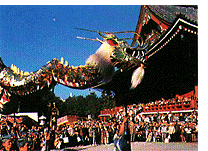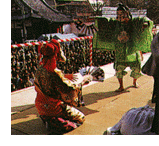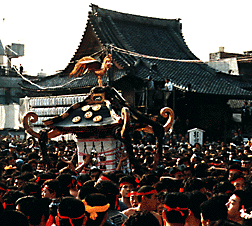 |
Spring Events in Asakusa |
|
|
|
|
Enjoy the four seasons in Asakusa
Some events may be canceled or postponed due to coronavirus(COVID-19) concerns.
Please check official websites for the latest updates and information. |
|
O-cha-tou-bi (Days for Acts of Merits) [March 4, April 18, May 18] There are various special temple festivals for Buddhist deities. For example, since ancient times, the festival for the Kannon has been held on the 18th of May and the festival for the Jizo on the 24th. Additional days to perform acts of merit were established after the late Muromachi era. It was said that worshipping on one of these days brings the same benefits as worshipping for one hundred days or one thousand days, and these special days to perform acts of merit became very common all over Japan. O-cha-tou-bi is another name for this day. Following an old custom, believers drink the tea that has been first offered to the Kannon. Tea is actually offered to the Kannon every day, but only on the day for performing acts of merit are believers allowed to drink it. Believers formed an organization called the O-cha-tou-ko which is today named Gessanko and its membership now consists of more than 5000 believers. The O-cha-tou-ko at Sensoji was organized during the Tempo era (1830-1843) and the leaflets that were issued by the organizers at the time still exist today. Kinryu-no-mai (Golden Dragon Dance at the unveiling of Asakusa Kannon) [March 18]  The official temple name for Sensoji Temple is Kinryuzan (Mountain of Golden Dragon) and this name comes from a tale about a golden dragon. According to the legend, 1000 pine trees suddenly appeared overnight near the temple on the 18th day of March. After three days, a golden dragon measuring 100 shaku (approx. 30 meters) descended into the pine trees from the heavens and was never seen again. The Golden Dragon Dance is based on this story. It was first presented in October 1958 to celebrate the opening of Showa Hall of the temple by the Asakusa Kannon Association as a commemorative event to be passed on to future generations. The dance is held on March 18 when the temple's sacred image is unveiled for public viewing and on October 18, an auspicious day for the Kiku-kuyo (Memorial Service for Chrysanthemums).
The official temple name for Sensoji Temple is Kinryuzan (Mountain of Golden Dragon) and this name comes from a tale about a golden dragon. According to the legend, 1000 pine trees suddenly appeared overnight near the temple on the 18th day of March. After three days, a golden dragon measuring 100 shaku (approx. 30 meters) descended into the pine trees from the heavens and was never seen again. The Golden Dragon Dance is based on this story. It was first presented in October 1958 to celebrate the opening of Showa Hall of the temple by the Asakusa Kannon Association as a commemorative event to be passed on to future generations. The dance is held on March 18 when the temple's sacred image is unveiled for public viewing and on October 18, an auspicious day for the Kiku-kuyo (Memorial Service for Chrysanthemums).Under the direction of the late Mantaro Kubota, the Kinryu-no-Mai dance was produced by Yoshio Yoshikawa, scored by Yoshiaki Machida and choreographed by Fujima Tomoaki. It is performed by more than 70 male volunteers from local youth organizations who first purify themselves before devoting themselves wholeheartedly to the dance. The Kinryu-no-Mai has become an established well-known local event. Asakusa Yabusame (horseback archery) [3rd Saturday of April ]  Yabusame, or the horseback archery that takes place in Asakusa, has a very long history.
Yabusame, or the horseback archery that takes place in Asakusa, has a very long history.During the Edo era, it was held every year on January 5 as one of the New Year's special events at Asakusa Shrine. This event has been described in detail in such historic documents as Sensoji-shi (A History of Sensoji Temple) and Toto-saijiki (The Chronicle of the East Capital). Back in olden times, horseback archery in Asakusa is believed to have been conducted in a different style than that currently seen in other regions in Japan. As a New Year's event backed by the devout faith of the local people, it must have indeed been a thrilling event for everyone. Today, Asakusa Yabusame follows the traditional style recreated with the cooperation of the head of the Ogasawara School of Archery and Horsemanship, and is held at Sumida Park at 11:00 a.m. Naki-zumo (Crying Baby Contest) in commemoration of the reconstruction of the statue of the 9th Danjuro in Shibaraku [4th Sunday of April ] All parents wish for their children to grow up strong and healthy. Behind Sensoji Temple, there is a statue of the 9th Danjuro in his role of Kamakura Gengoro in the Kabuki play Shibaraku. The statue shows him as the famous brave and strong-willed child in bangs who spoke his forceful lines in child-like speech. In honor of the 9th Danjuro's performance of this role, naki-zumo has been held at Sensoji Temple since 1991. Fukujyu-no-mai (In commemoration of the opening of the Hozomon Gate of Sensoji Temple) [May 5] Shichifukujin-no-mai and Takara-no-mai Takara-no-mai (Treasure Dance) A treasure ship called Takarabune has been popular since ancient times as the ship on which the Shichi-fukujin appear. In the Takara-no-mai or "treasure dance" which celebrates the blessings and goodness of the Kannon, the treasure ship is pulled by many young children. This dance began in 1972 and it is performed by the children of Sensoji Kindergarten. Performance day : May 5(Children's Day)  Shichifukujin-no-mai (Dance of the Seven Gods of Good Fortune)
Shichifukujin-no-mai (Dance of the Seven Gods of Good Fortune)
Since ancient times, the common people have worshipped the Shichi-fukujin (Seven Gods of Good Fortune) as gods who bring happiness and prosperity. One of the subordinate shrines of Sensoji Temple is also dedicated to the worship of the Shichi-fukujin and is a site of pilgrimage to honor them. The owner of the theater company, Ichimura-za, one of the three Saruwaka-za companies, was a devout believer in the Asakusa Kannon and he began giving a performance of the Shichi-fukujin-no-mai (Dance of the Seven Gods of Good Fortune) before his company's main performance as an act of religious merit dedicated to the Kannon. The Shichi-fukujin-no-mai is danced to nagauta music and is said to have been composed by the third Kineya Uemon, premier shamisen player of the Ichimura-za Theater Company sometime between 1716 and 1751. It was performed before the main performance every day as a customary opening act by the actors of Inari-cho (lower ranking actors) until the early Meiji era. Consequently, the Shichi-fukujin-no-mai by the Ichimura-za Theater Company has deep roots in Asakusa and was revived to commemorate the opening of the Hozomon Gate on April 1, 1964. In the dance, two of the gods, Ebisu and Daikoku, show their real faces, while the other five conceal their faces with masks. All the costumes and props are faithful reproductions of the Shichi-fukujin as they have been depicted since the olden days. Ebisu and Daikoku are the only ones to dance as the others watch from the rear of the stage.
Sanja-matsuri Festival (Asakusa's Main Spring Event) [3rd Sun. of May and the proceeding Fri. and Sat.] * May 13 to15, 2016

Long ago, the Sanja-matsuri (Sanja Festival) was held every year on March 17 and 18, but this was changed to May 17 and 18 in 1873, and later to the third Sunday of May and the preceding Friday and Saturday in recent years. An ancient Shinto ritual called Binzasara-mai is held at the beginning of Sanja-matsuri. Made up of ancient music and dance derived from the medieval traditions of Dengaku-mai, it has been designated as an intangible cultural property by the Tokyo metropolitan government. The Sanja-matsuri is famous for its spectacular procession of portable shrines. The portable shrines from parishioner organizations of Asakusa Shrine in each of the 44 neighborhoods gather at 1 p.m. on Saturday in the precincts of Sensoji Temple, giving Asakusa a festive atmosphere. The three portable shrines are carried out of Asakusa shrine at 6 a.m. on Sunday. Each of them is carried off in three different directions and taken around the communities of the parishioner organizations. For information on the procession route, contact the Asakusa Tourist Center (corner in front of Kaminarimon) or the route map on display in front of the JTB Asakusa office. Please take care when watching the procession because it can be dangerous as the shrines pass by. Schedule
Due to the festival, Kaminarimon-dori and Umamichi-dori will be closed to motor traffic from 11:00 a.m. to 6 p.m.
|
| Source: Asakusa Tourism Association |
|
|
Exploring Delicious Asakusa | Asakusa Map |
|
| |||||
| Back to Menu | |||||